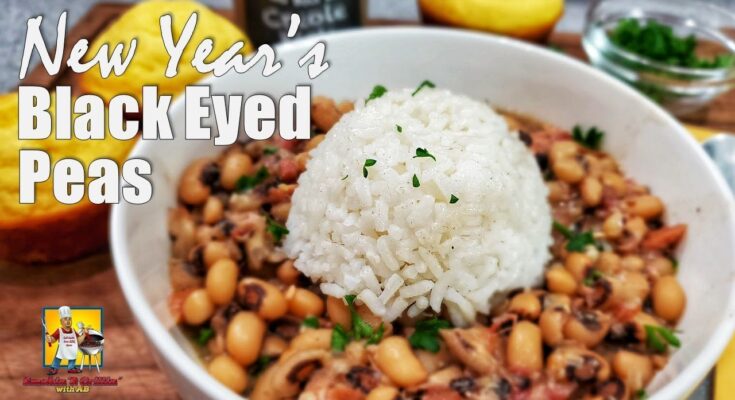Black Eyed Peas Recipe: Looking to prepare a comforting and nutritious meal? Black-eyed peas are a fantastic choice!
Whether you want a hearty Southern dish or a light vegetarian meal, these legumes are incredibly versatile. Packed with fiber, protein, and essential nutrients, black-eyed peas are a staple in many cultures around the world.
In this guide, we’ll walk you through everything you need to know about making delicious black-eyed peas from scratch—whether you prefer stovetop cooking or using a pressure cooker.
What are Black-Eyed Peas?
Black-eyed peas, also known as cowpeas, are small, creamy-colored beans with a distinctive black spot or “eye.” Originating from Africa, they’ve become an essential part of Southern cuisine in the United States. These legumes are celebrated not only for their taste but also for their high nutritional value—offering a great source of protein, fiber, folate, and iron.
Ingredients for Black-Eyed Peas Recipe
Here’s what you’ll need for a basic black-eyed peas recipe:
- 1 pound black-eyed peas (dried or canned)
- 1 onion, diced
- 2 garlic cloves, minced
- 1-2 bay leaves
- 4 cups chicken or vegetable broth
- 1 teaspoon salt
- 1/2 teaspoon black pepper
- Optional: Smoked meat (like ham hocks, bacon, or sausage)
- Optional: Cayenne pepper or hot sauce for heat
You can swap meat-based broth for vegetable broth to keep things vegetarian.
Kitchen Tools You’ll Need
- Large pot or Dutch oven
- Colander for rinsing peas
- Cutting board and knife
- Wooden spoon for stirring
- Pressure cooker or Instant Pot (optional)
Soaking the Black-Eyed Peas: Is it Necessary?
Soaking dried peas helps reduce cooking time and improves digestibility. If you plan ahead, soak the peas overnight in cold water.
Quick Soak Method: Boil the peas for 2 minutes, then turn off the heat and let them sit for 1 hour.
How to Prepare Black-Eyed Peas Without Soaking
Pressed for time? No worries! You can cook dried black-eyed peas without soaking. Just increase the cooking time to 1.5 to 2 hours, ensuring they’re tender.
Step-by-Step Guide to Cooking Black-Eyed Peas on the Stovetop
- Rinse the peas: Use a colander to rinse the peas under cold water to remove any dirt or debris.
- Sauté aromatics: In a large pot, heat a tablespoon of oil and sauté the onions and garlic until fragrant.
- Add peas and broth: Add the black-eyed peas, broth, bay leaves, salt, and pepper. Stir well.
- Bring to a boil: Once boiling, reduce heat to low and simmer for 45 minutes to 1 hour. Stir occasionally.
- Check for tenderness: Test the peas—if soft and creamy, they’re ready! If not, cook for another 10-15 minutes.
- Remove bay leaves and adjust seasoning before serving.
How to Make Black-Eyed Peas in a Pressure Cooker or Instant Pot
Cooking black-eyed peas in a pressure cooker saves time and locks in flavors.
- Add ingredients: Place all ingredients in the pressure cooker.
- Set cooking time: Cook on high pressure for 15-20 minutes.
- Release pressure: Let the pressure release naturally for 10 minutes, then perform a quick release.
- Check tenderness: If needed, cook for another 5 minutes.
How to Make Black-Eyed Peas with Meat (Optional)
For a smoky flavor, add ham hocks, bacon, or sausage. Sauté the meat first, then proceed with adding aromatics, peas, and broth. The meat will infuse the broth, giving the dish a rich, savory taste.
Seasoning Options for Black-Eyed Peas
- Herbs: Thyme, oregano, or parsley.
- Spices: Paprika, cayenne, cumin, or garlic powder.
- Hot Sauce: A dash of your favorite hot sauce for some heat.
Vegetarian and Vegan Black-Eyed Peas Variations
Skip the meat and use vegetable broth for a vegan version. Add diced carrots, bell peppers, or leafy greens like kale for extra texture and flavor.
Serving Suggestions
Black-eyed peas pair beautifully with cornbread, collard greens, or white rice. In Southern cuisine, they’re often enjoyed with a side of greens and a splash of hot sauce.
Storage and Reheating Tips
Store leftovers in an airtight container in the fridge for up to 4 days. To reheat, simmer gently on the stove or microwave until warmed through. Add a splash of broth if needed to restore the texture.
Common Mistakes to Avoid When Cooking Black-Eyed Peas
- Mushy peas: Avoid overcooking by checking regularly for doneness.
- Under-seasoning: Black-eyed peas soak up flavors—season generously.
- Skipping aromatics: Onions, garlic, and herbs elevate the flavor profile.
FAQs about Black-Eyed Peas Recipe
1. What are black-eyed peas?
Black-eyed peas are a type of legume known for their distinctive black spot on a creamy beige surface. They are popular in Southern cooking and are often associated with good luck when eaten on New Year’s Day.
2. What ingredients do I need to make black-eyed peas?
The basic recipe requires dried or canned black-eyed peas, onions, garlic, smoked meat (like bacon or ham hock), broth, and seasonings such as salt, pepper, and bay leaves. Optional additions include tomatoes, greens, and hot peppers for extra flavor.
3. How long does it take to cook black-eyed peas?
Dried black-eyed peas usually take 1-2 hours to cook on the stovetop, though soaking them overnight can reduce cooking time. If using an Instant Pot or slow cooker, cooking time will vary between 30 minutes to 6 hours, depending on the method.
4. Do I need to soak black-eyed peas before cooking?
Soaking is not mandatory but recommended for dried peas. It softens the legumes and reduces cooking time. A quick soak method involves boiling the peas for 2 minutes, then letting them sit for an hour before cooking.
5. What can I serve with black-eyed peas?
They pair well with cornbread, rice, or greens like collard or mustard greens. You can also serve them as a side dish with fried chicken, pork chops, or roasted vegetables.
6. Can I freeze leftover black-eyed peas?
Yes, cooked black-eyed peas can be stored in an airtight container and frozen for up to 3 months. Make sure to let them cool before freezing.
7. How can I add more flavor to black-eyed peas?
Enhance the flavor by cooking with smoked meats, adding spices like cumin or paprika, or incorporating aromatics such as onions, garlic, and thyme. A dash of hot sauce or a splash of vinegar can also elevate the dish.
Conclusion
There you have it—a simple, foolproof guide to cooking black-eyed peas! Whether you prefer a smoky meat version or a light vegan dish, black-eyed peas are an easy and satisfying meal. Try experimenting with different herbs and spices to make the recipe your own!
References
For further reading and to validate the information shared in the Black Eyed Peas Recipe, we recommend exploring the following reputable sources. These references provide additional insights, variations, and expert tips to enhance your cooking experience:
- AllRecipes – Discover user-generated recipes, reviews, and cooking techniques.
- Food Network – Explore professional chefs’ takes on classic dishes, including creative variations of black-eyed peas.
- BBC Good Food – Access international culinary tips and recipes with a focus on healthy, flavorful meals.
- Epicurious – Browse gourmet recipes with tips for mastering key cooking techniques.
- The Spruce Eats – Learn practical cooking advice along with easy-to-follow, family-friendly recipes.
Using these trusted sources will help you explore new ways to prepare black-eyed peas and ensure you create a flavorful dish every time!



